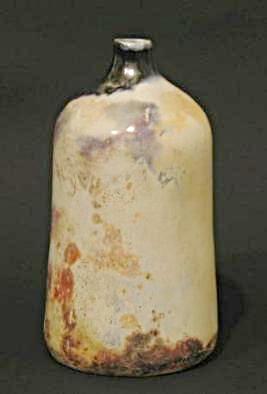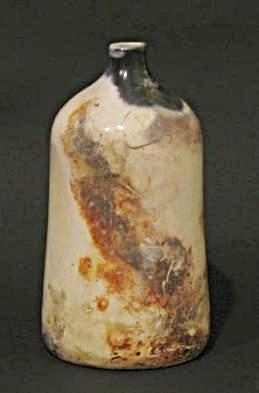Some of my best pit fired pieces came from my very first pit fire in 2002. I had just taken a saggar firing workshop with Maria Spies, where I learned a few things about terra sigillata and packing materials for fuming colors onto pots — all saggar techniques directly transferrable to pit firing. Also, by this time my potter friends Dan Ebert and Gary Georger had already done two or three pit fires with various degrees of success. So one sunny Saturday morning in early September I joined them and a few others at the beach and had my first pit fire experience.
I’ll write about the firing itself next time; here I just want to show a few pictures of the firing results, along with some description about the packing materials and the kind of terra sigillata, if any, used for each pot.

This bottle with a small neck (figure 1) stands about 6 1/2 inches (17 cm) tall. Clay body is a white porcelaneous cone 6 stoneware clay. A white terra sigillata with titanium dioxide added (about 2 teaspoons to one cup of liquid terra sig) was applied, burnished to produce a high sheen, and then bisqued to cone 06 before the pit fire. The titanium dioxide in the terra sig gave the pot a creamy white surface that seemed particularly receptive to subtle hues from the smoking and fuming that occurred in the pit during the firing.

Here is another view (figure 2) of the same piece. For a long time I had thought the band of colors running diagonally across the piece (upper left to lower right) was the result of a piece of steel wool that I had placed there; but recently I went back to my notebook and discovered that the steel wool was on a different pot in the same firing instead of this one. I do remember distinctly of scrubbing some crusty, rusted-metal looking gunk away after the firing to get this band of colors looking like it does today. That’s probably why I had thought it was steel wool that I was scrubbing away. So what was it? My notebook entry for this pot has a list of three items for packing materials: (1) fern + clay mask; (2) salted grasses; and (3) …
The first, “fern + clay mask”, requires an explanation: I had read Dick Lehman‘s article on his method of transferring carbonized images of vegetation onto pots in Barrel Pit and Saggar Firing, and thought I’d try his technique on this pot — except I didn’t get anything even remotely looking like it here. The second, salted grasses, is basically artificial seaweed similar to the salted raffia I described in a previous post. But what on earth was that indecipherable third item, ‘…’?
A lesson learned: take copious notes — ignore all those dilettantes who will try to convince you that you don’t need to take notes — and don’t assume something is so obvious that you don’t need to write it down. You won’t remember why it was so obvious in six months! When in doubt, spell it out.